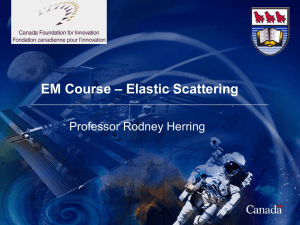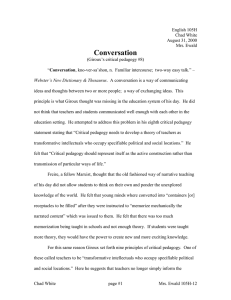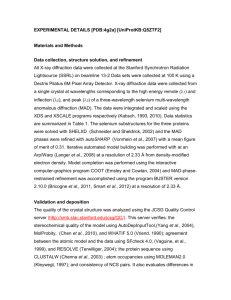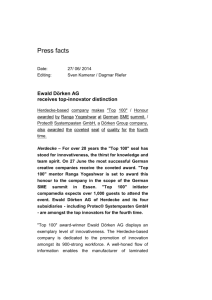Editorial P. P. Ewald Memorial Issue
advertisement
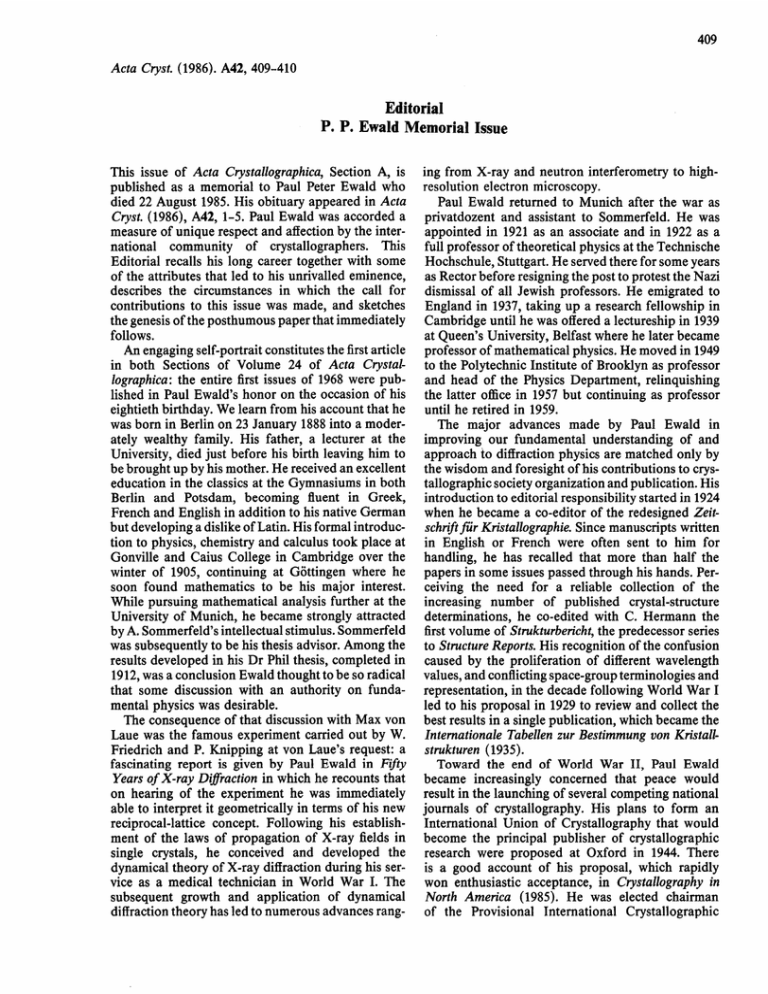
409 Acta Cryst. (1986). A42, 409-410 Editorial P. P. Ewald Memorial Issue This issue of Acta Crystallographica, Section A, is published as a memorial to Paul Peter Ewald who died 22 August 1985. His obituary appeared in Acta Cryst. (1986), A42, 1-5. Paul Ewald was accorded a measure of unique respect and affection by the international community of crystallographers. This Editorial recalls his long career together with some of the attributes that led to his unrivalled eminence, describes the circumstances in which the call for contributions to this issue was made, and sketches the genesis of the posthumous paper that immediately follows. An engaging self-portrait constitutes the first article in both Sections of Volume 24 of Acta Crystallographica" the entire first issues of 1968 were published in Paul Ewald's honor on the occasion of his eightieth birthday. We learn from his account that he was born in Berlin on 23 January 1888 into a moderately wealthy family. His father, a lecturer at the University, died just before his birth leaving him to be brought up by his mother. He received an excellent education in the classics at the Gymnasiums in both Berlin and Potsdam, becoming fluent in Greek, French and English in addition to his native German but developing a dislike of Latin. His formal introduction to physics, chemistry and calculus took place at Gonville and Caius College in Cambridge over the winter of 1905, continuing at G&tingen where he soon found mathematics to be his major interest. While pursuing mathematical analysis further at the University of Munich, he became strongly attracted by A. Sommerfeld's intellectual stimulus. Sommerfeld was subsequently to be his thesis advisor. Among the results developed in his Dr Phil thesis, completed in 1912, was a conclusion Ewald thought to be so radical that some discussion with an authority on fundamental physics was desirable. The consequence of that discussion with Max von Laue was the famous experiment carded out by W. Friedrich and P. Knipping at von Laue's request: a fascinating report is given by Paul Ewald in Fifty Years of X-ray Diffraction in which he recounts that on hearing of the experiment he was immediately able to interpret it geometrically in terms of his new reciprocal-lattice concept. Following his establishment of the laws of propagation of X-ray fields in single crystals, he conceived and developed the dynamical theory of X-ray diffraction during his service as a medical technician in World War I. The subsequent growth and application of dynamical diffraction theory has led to numerous advances rang- ing from X-ray and neutron interferometry to highresolution electron microscopy. Paul Ewald returned to Munich after the war as privatdozent and assistant to Sommerfeld. He was appointed in 1921 as an associate and in 1922 as a full professor of theoretical physics at the Technische Hochschule, Stuttgart. He served there for some years as Rector before resigning the post to protest the Nazi dismissal of all Jewish professors. He emigrated to England in 1937, taking up a research fellowship in Cambridge until he was offered a lectureship in 1939 at Queen's University, Belfast where he later became professor of mathematical physics. He moved in 1949 to the Polytechnic Institute of Brooklyn as professor and head of the Physics Department, relinquishing the latter office in 1957 but continuing as professor until he retired in 1959. The major advances made by Paul Ewald in improving our fundamental understanding of and approach to diffraction physics are matched only by the wisdom and foresight of his contributions to crystallographic society organization and publication. His introduction to editorial responsibility started in 1924 when he became a co-editor of the redesigned Zeitschriftfiir Kristallographie. Since manuscripts written in English or French were often sent to him for handling, he has recalled that more than half the papers in some issues passed through his hands. Perceiving the need for a reliable collection of the increasing number of published crystal-structure determinations, he co-edited with C. Hermann the first volume of Strukturbericht, the predecessor series to Structure Reports. His recognition of the confusion caused by the proliferation of different wavelength values, and conflicting space-group terminologies and representation, in the decade following World War I led to his proposal in 1929 to review and collect the best results in a single publication, which became the Internationale Tabellen zur Bestimmung yon Kristallstrukturen (1935). Toward the end of World War II, Paul Ewald became increasingly concerned that peace would result in the launching of several competing national journals of crystallography. His plans to form an International Union of Crystallography that would become the principal publisher of crystallographic research were proposed at Oxford in 1944. There is a good account of his proposal, which rapidly won enthusiastic acceptance, in Crystallography in North America (1985). He was elected chairman of the Provisional International Crystallographic 410 EDITORIAL Committee at the 1946 meeting in London of crystallographers from some thirteen countries. The Committee also nominated him as Editor of a journal to be published by the new Union. Acceptance by the International Council of Scientific Unions in 1947 of the statutes that his Provisional Committee prepared set in motion the steps that led to the first issue of Acta Crystallographica in early 1948. Paul Ewald chaired the first General Assembly and International Congress of the International Union of Crystallography, held at Harvard University in 1948. He served on the IUCr Executive Committee from its beginning until 1966, first as Editor, then on election to the Vice-Presidency in 1957 and finally as President in 1960. He had previously been elected President of the American Crystallographic Association, in 1952. During his term as Editor of Acta Crystallographica, which lasted from 1948 until 1959, the total number of papers published annually grew from 76 to 274. His standards of excellence have endured as the journal's sine qua non ever since. Paul Ewald died before the end of the annual meeting of the American Crystallographic Association in Stanford, but this news did not reach the members there. Shortly thereafter, the suggestion of honoring his memory by publishing a series of papers in the field of dynamical diffraction was made. An informal international committee, with John M. Cowley and Heinrich Wagenfeld as co-chairmen and A. Authier, M. Hart, J. K. Gj0nnes, G. Hildebrandt, N. Kato and B. K. Vainshtein as members, was charged with encouraging all who use dynamical diffraction theory to submit an original contribution for inclusion in the Ewald Memorial Issue, on the understanding that all manuscripts would be refereed normally. The selection of papers that follows attests both to the diligence of the Committee and the responsiveness of the dynamical diffraction community. It is probably not too large an assumption to think that Paul Ewald would have greatly enjoyed this particular issue. The posthumous appearance of the first paper in this issue calls for an explanation. Paul Ewald sent the manuscript to Professor Ben Post about 1980 or 1981 with the purpose of stimulating an experiment that would determine the possible effect of n-beam interactions on the precise wavelength of X-rays, in view of the general use of perfect crystals such as Si in wavelength measurement. The experiment has not been completed, but the manuscript was considered to have sufficient interest for inclusion here. The eminent referees whose comments clarified the terminology of this paper are gratefully acknowledged as are all those others whose anonymous efforts have added extra value to further papers in this issue. All authors are to be particularly commended for making such significant contributions within the restricted period necessary for this issue to appear now.
